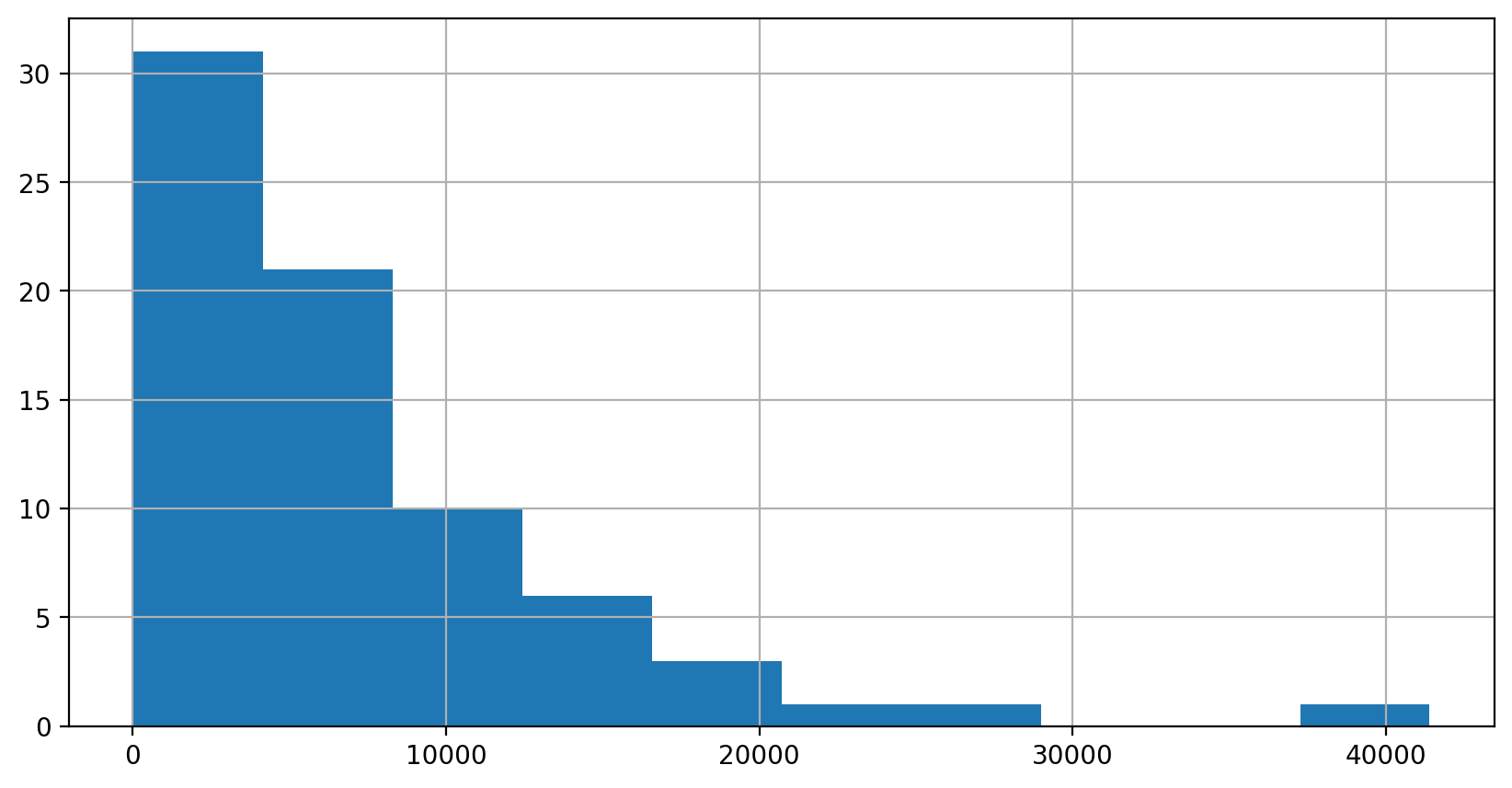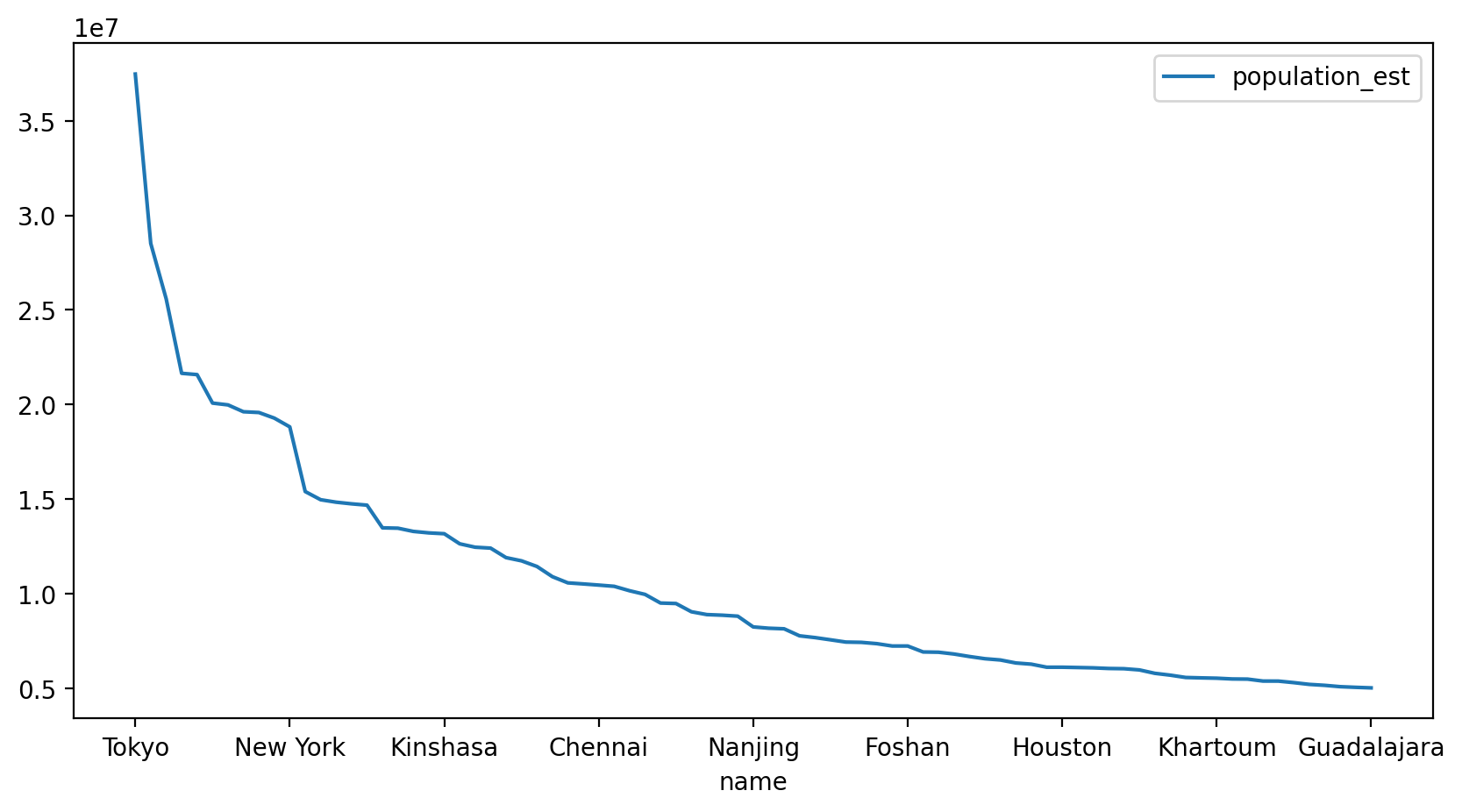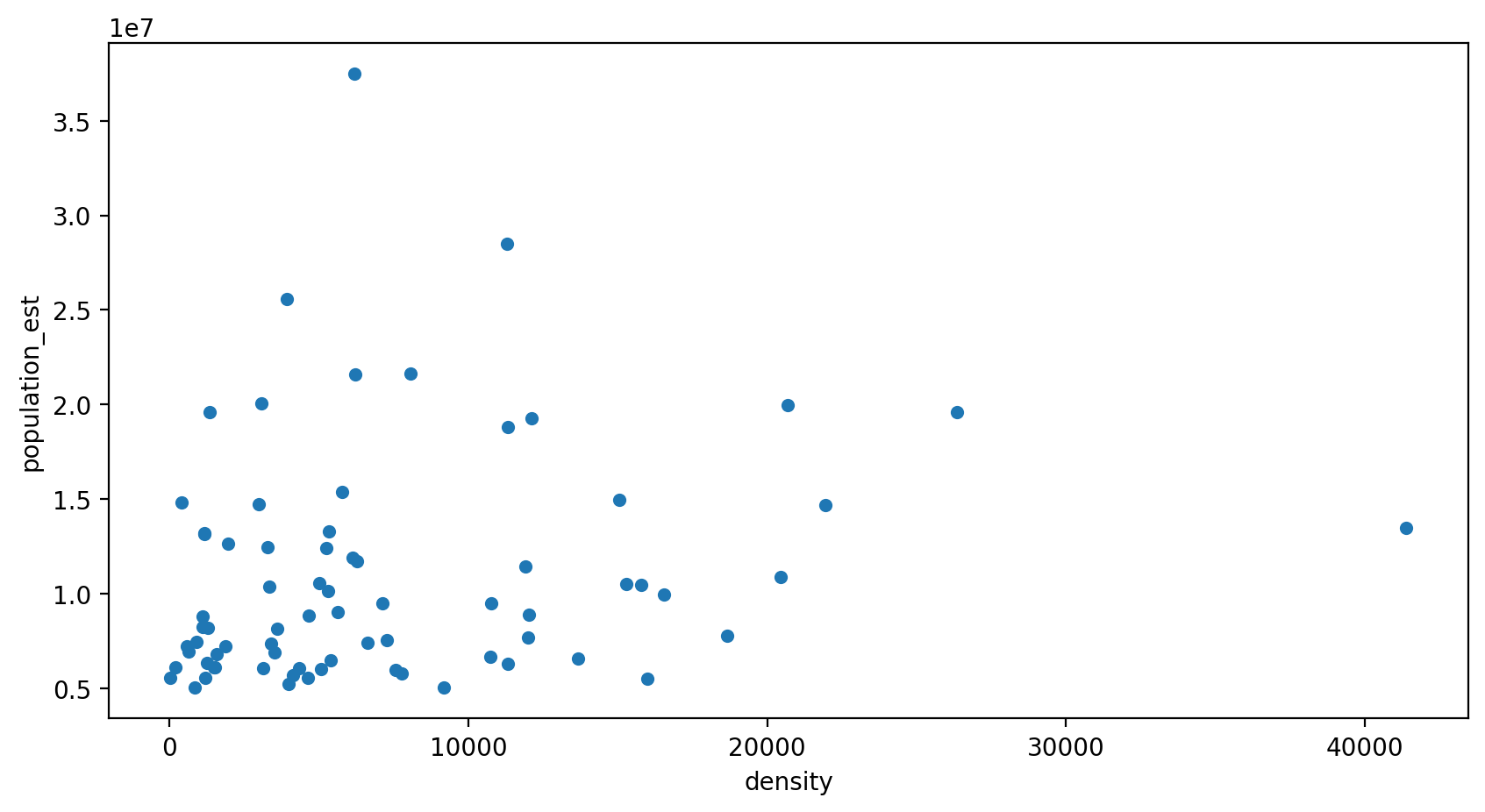import numpy as npimport pandas as pdimport matplotlib.pyplot as plt= 50
Series
Series are one-dimensional objects like lists, numpy arrays or table columns. Each series has an index that can be used to find elements. By default this is an integer from 0 to n-1.
= [3 , "foo" , 3.14 , 42 , - 23 , "bar" ]
0 3
1 foo
2 3.14
3 42
4 -23
5 bar
dtype: object
= ["a" , "b" , "c" , "d" , "e" , "f" ]
= pd.Series(values, index= index)
a 3
b foo
c 3.14
d 42
e -23
f bar
dtype: object
a 3
b foo
c 3.14
dtype: object
= pd.Series(np.arange(10 ), index= np.arange(10 , 20 ))> 5 ]
16 6
17 7
18 8
19 9
dtype: int64
DataFrames
Are two-dimensional data structures similar to tables or Excel sheets. Basically a collection of Series. We use the table of the largest cities in Europe from wikipedia as an example here.
= "https://en.wikipedia.org/wiki/List_of_largest_cities" = pd.read_html(cities_url, header= 0 , flavor= "bs4" )
<class 'pandas.core.frame.DataFrame'>
RangeIndex: 83 entries, 0 to 82
Data columns (total 13 columns):
# Column Non-Null Count Dtype
--- ------ -------------- -----
0 City[a] 82 non-null object
1 Country 82 non-null object
2 UN 2018 population estimates[b] 82 non-null object
3 City proper[c] 82 non-null object
4 City proper[c].1 82 non-null object
5 City proper[c].2 82 non-null object
6 City proper[c].3 82 non-null object
7 Urban area[8] 82 non-null object
8 Urban area[8].1 82 non-null object
9 Urban area[8].2 82 non-null object
10 Metropolitan area[d] 82 non-null object
11 Metropolitan area[d].1 82 non-null object
12 Metropolitan area[d].2 82 non-null object
dtypes: object(13)
memory usage: 8.6+ KB
= True )
Index 132
City[a] 4711
Country 4621
UN 2018 population estimates[b] 4681
City proper[c] 5302
City proper[c].1 4727
City proper[c].2 4462
City proper[c].3 4945
Urban area[8] 4690
Urban area[8].1 4381
Urban area[8].2 4493
Metropolitan area[d] 5269
Metropolitan area[d].1 5101
Metropolitan area[d].2 5236
dtype: int64
Method Chaining
= (df.dropna()= df.iloc[0 ]).drop(df.index[0 ])= str .lower)= {"city[a]" : "name" , "index" : "rank" }) = lambda x: pd.Categorical(x["country" ]),= lambda x: pd.Categorical(x["name" ]),= lambda x: x["un 2018 population estimates[b]" ].astype(np.int32),= lambda x: pd.Categorical(x["definition" ]),= lambda x: x["density (/km2)" ].iloc[:, 0 ].str .replace("," , "" ).str .extract(r'(\d+)' ).astype(np.float32),= lambda x: x["rank" ] - 1 "rank" , "name" , "country" , "definition" , "population_est" , "density" ]]
<class 'pandas.core.frame.DataFrame'>
RangeIndex: 81 entries, 0 to 80
Data columns (total 6 columns):
# Column Non-Null Count Dtype
--- ------ -------------- -----
0 rank 81 non-null int64
1 name 81 non-null category
2 country 81 non-null category
3 definition 81 non-null category
4 population_est 81 non-null int32
5 density 74 non-null float32
dtypes: category(3), float32(1), int32(1), int64(1)
memory usage: 6.9 KB
0
1
Tokyo
Japan
Metropolis prefecture
37468000
6169.0
1
2
Delhi
India
Municipal corporation
28514000
11289.0
2
3
Shanghai
China
Municipality
25582000
3922.0
3
4
São Paulo
Brazil
Municipality
21650000
8055.0
4
5
Mexico City
Mexico
City-state
21581000
6202.0
= "density" , ascending= False ).head()
16
17
Manila
Philippines
Capital city
13482000
41399.0
8
9
Dhaka
Bangladesh
Capital city
19578000
26349.0
15
16
Kolkata
India
Municipal corporation
14681000
21935.0
6
7
Mumbai
India
Municipal corporation
19980000
20694.0
27
28
Paris
France
Commune
10901000
20460.0
Indices
Simple
= df.set_index("rank" )
2 :5 , "country" : "population_est" ].head()
rank
2
India
Municipal corporation
28514000
3
China
Municipality
25582000
4
Brazil
Municipality
21650000
5
Mexico
City-state
21581000
"Paris" , "Dhaka" )), "country" : "population_est" ].head()
rank
9
Bangladesh
Capital city
19578000
28
France
Commune
10901000
Multidimensional
0
1
Tokyo
Japan
Metropolis prefecture
37468000
6169.0
1
2
Delhi
India
Municipal corporation
28514000
11289.0
2
3
Shanghai
China
Municipality
25582000
3922.0
3
4
São Paulo
Brazil
Municipality
21650000
8055.0
4
5
Mexico City
Mexico
City-state
21581000
6202.0
= df.set_index(["country" , "definition" , "rank" ]).sort_index()
definition
rank
City (sub-provincial)
22
Guangzhou
12638000
1950.0
25
Shenzhen
11908000
6111.0
40
Chengdu
8813000
1116.0
41
Nanjing
8245000
1103.0
42
Wuhan
8176000
1282.0
47
Xi'an
7444000
887.0
50
Hangzhou
7236000
570.0
52
Shenyang
6921000
639.0
60
Harbin
6115000
200.0
75
Qingdao
5381000
NaN
76
Dalian
5300000
NaN
80
Jinan
5052000
849.0
Municipality
3
Shanghai
25582000
3922.0
8
Beijing
19618000
1334.0
14
Chongqing
14838000
389.0
20
Tianjin
13215000
1163.0
Prefecture-level city
49
Dongguan
7360000
3384.0
51
Foshan
7236000
1870.0
58
Suzhou
6339000
1263.0
Special administrative region
48
Hong Kong
7429000
6611.0
Simple Plots
= df.density.hist(figsize= size)
= df.plot(x= "name" , y= "population_est" , figsize= size)
= df.plot.scatter(x= "density" , y= "population_est" , figsize= size)
Grouping
= (df[["country" , "population_est" , "name" ]]"country" , observed= False )"population_est" : "sum" , "name" : "count" })= {"name" : "cities" })= "cities" , ascending= False )12 ))
6
China
194846000
20
34
United States
74865000
9
11
India
115074000
9
15
Japan
71807000
4
3
Brazil
40915000
3
20
Pakistan
27138000
2
23
Russia
17793000
2
17
Mexico
26604000
2
9
Egypt
25162000
2
28
Spain
11991000
2
26
South Africa
5486000
1
24
Saudi Arabia
6907000
1
How often do which values occur in a column?
cities
2 5
9 2
1 2
20 1
4 1
3 1
Name: count, dtype: int64
Fetch the inhabitants per country
= "https://en.wikipedia.org/wiki/List_of_countries_and_dependencies_by_population" = pd.read_html(countries_url, header= 0 , flavor= "bs4" , decimal= "," , thousands= "." )
"1,34.5" .replace(",." , "" )
= (dc.rename(columns= str .lower)= lambda x: x["population" ].str .replace(r"[.,]" , "" , regex= True ).astype(np.int64),= lambda x: pd.Categorical(x["country / dependency" ])"country" , "population" ]]
0
World
8068346000
1
China
1411750000
2
India
1392329000
3
United States
335576000
4
Indonesia
279118866
query
"population > 10**6 and country in ('Niger', 'United States', 'India')" )
2
India
1392329000
3
United States
335576000
56
Niger
25369415
6
China
194846000
20
34
United States
74865000
9
11
India
115074000
9
15
Japan
71807000
4
3
Brazil
40915000
3
20
Pakistan
27138000
2
23
Russia
17793000
2
17
Mexico
26604000
2
9
Egypt
25162000
2
28
Spain
11991000
2
26
South Africa
5486000
1
24
Saudi Arabia
6907000
1
Join - like in SQL
= (pd.merge(dt, dc, on= "country" )[["country" , "cities" , "population_est" , "population" ]]= {"population_est" : "in_cities" , "population" : "total" }))
0
China
20
194846000
1411750000
1
United States
9
74865000
335576000
2
India
9
115074000
1392329000
3
Japan
4
71807000
124340000
4
Brazil
3
40915000
203062512
5
Pakistan
2
27138000
241499431
6
Russia
2
17793000
146424729
7
Mexico
2
26604000
129202482
8
Egypt
2
25162000
105481000
9
Spain
2
11991000
48345223
10
South Africa
1
5486000
62027503
11
Saudi Arabia
1
6907000
32175224
"city_ratio" ] = dm.in_cities / dm.total
0
China
20
194846000
1411750000
0.138017
1
United States
9
74865000
335576000
0.223094
2
India
9
115074000
1392329000
0.082649
3
Japan
4
71807000
124340000
0.577505
4
Brazil
3
40915000
203062512
0.201490
5
Pakistan
2
27138000
241499431
0.112373
6
Russia
2
17793000
146424729
0.121516
7
Mexico
2
26604000
129202482
0.205909
8
Egypt
2
25162000
105481000
0.238545
9
Spain
2
11991000
48345223
0.248029
10
South Africa
1
5486000
62027503
0.088445
11
Saudi Arabia
1
6907000
32175224
0.214668
Often used Operations
= pd.DataFrame(index= ["A" , "B" , "C" ])"name" ] = ["foo" , "bar" , "baz" ]"value" ] = [23 , 42 , 28 ]
A
foo
23
B
bar
42
C
baz
28
0
A
foo
23
1
B
bar
42
2
C
baz
28
= df.reset_index().melt(id_vars= ["index" ], value_name= "new_value" )
0
A
name
foo
1
B
name
bar
2
C
name
baz
3
A
value
23
4
B
value
42
5
C
value
28
= "variable" , values= "new_value" , index= "index" )
index
A
foo
23
B
bar
42
C
baz
28


